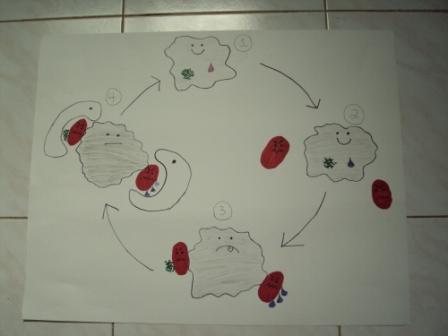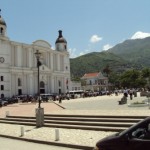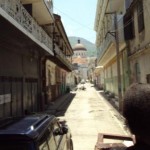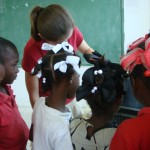Was Blind, But Now I See
The mobile clinic last Saturday was definitely one of the highlights of my time in Haiti so far.

Setting up the mobile clinic in Phaeton
I know Kelly described the clinic in detail already, so I’ll just add a few of my own observations while working with Dr. Lucien.

Kelly and Josenide examining a hematocrit sample
A majority of Dr. Lucien’s patients, about 25 total, received post-op care after having cataract surgery over a month ago. She performed surgeries in only one eye per patient in order to minimize risk of infection and complications (I think this is the standard procedure for all cataract surgeries).
While Dr. Lucien brought several of her own supplies on the trip, she was also able to use the equipment in the diagnostic eye pack as well. Our main goal in bringing all of the backpacks to Haiti is to observe their use by physicians and receive feedback in order to improve upon the designs.
The exam protocol was similar for each patient. Dr. Lucien’s assistant first checked patients’ visual acuity with a vision chart in the front of the building, and then Dr. Lucien examined patients in a room away from sunlight. She examined the patients’ treated and untreated eyes with a direct ophthalmoscope, slit lamp, headlight, and penlight. I was able to view a few of the patient’s intraocular lenses that were implanted after the removal of the cataract with the slit lamp, as well as the patients’ clouded cataracts in the untreated eyes.

Paul, Dr. Lucien's assistant, performing vision tests
After visually examining the eyes, Dr. Lucien numbed some of the patients’ eyes with medication and used a tonometer to measure the intraocular pressure of the eye. In one case, the patients’ pressure was very high, which indicated glaucoma. Dr. Lucien explained that this was why the patient’s surgery was not nearly as successful as it could have been because of his underlying glaucoma condition.

Dr. Lucien examining a patient with the portable slit lamp
Another particularly interesting case involved a non-cataract patient. A middle-aged gentleman had difficulty seeing in his right eye, but the reason for his poor vision was not immediately obvious. Dr. Lucien applied drops to dilate his pupil, and after examining him again she noticed that he had scarring on his retina and prescribed him with medication.
While post-op complications seemed to be minimal, the joy of regained sight was infectious. When Dr. Lucien asked one woman how she was doing since her surgery, she replied, “M’ap danse!,” which means “I’m dancing!” in Creole. Another woman said “Grace à Dieu, grace à Dieu” several times, meaning “thanks be to God,” for her restored sight. There were many other comments made by the patients, but I could only translate the relieved and grateful looks on their faces.
I cannot imagine how it must feel to have sight restored after months or even years of blindness. While working on my project during the school year, I learned that in places like Haiti and other developing countries where surgical eye care is not readily available, a vast majority of people with cataract accept their blindness as a permanent condition and learn to live with it. Dr. Lucien’s work in Haiti is a testament to the fact that Haitians should not and do not have to learn to live with treatable blindness.
I could not ask to observe and work with a more respectable and adaptable physician. Dr. Lucien managed to see 25 patients in less than 4 hours while dealing with sweltering heat, chickens strolling through the exam room, equipment malfunctions, and other interruptions and distractions. It was certainly a sight to behold (and thanks to her skillful work, her patients could!).

Kelly and I sporting the backpacks. Huge hit on the medical fashion runway 🙂
Since the mobile clinic last week and the end of school, Kelly and I have been working on various small projects to prepare for the graduation next Sunday. We’ve also been assisting one of the technicians at the clinic with the entry of electronic medical records.
I think I can speak for Kelly, too, when I say that we miss the kids dearly. We’ve still got our rooster, donkey, and cow neighbors to keep our little Haitian countryside symphony going, but it’s oddly quiet at 8 in the morning without 600 kids outside of our window.
Also, I was a little under the weather after the clinic, but I’m feeling 100% better now thanks to Kelly and the school staff’s attentive care. I’m pretty sure the entire town of Terrier Rouge knew I was sick. No, really: I saw our translator on Tuesday, after not seeing him since last Friday, and he knew I had been sick, and another preschool teacher asked me if I was feeling better too. Word travels fast around here!
A few visitors and relatives of the Brunos are in town this weekend for the St. Pierre (Terrier Rouge’s patron saint) festival, so it should be an exciting and busy weekend.











